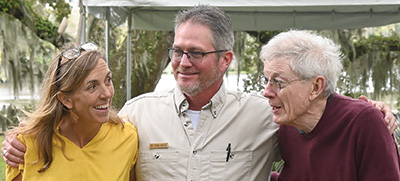Environment
Waccamaw refuge marks a quarter century, 38,000 acres and a little more

As the visitors were called to their seats on a bluff overlooking the Pee Dee River, an alligator in the dark water pushed its nose toward the bank in the shadow of a spreading live oak. Crowds are rare on this stretch of the river, where Thoroughfare Creek branches off toward Sandy Island.
Many of those who gathered over the weekend at Hasty Point had been there in 1997 to celebrate the creation of the Waccamaw National Wildlife Refuge. The former rice plantation wasn’t part of the refuge. It was just outside the 54,000-acre acquisition boundary.
Tom Follrath, the head of the realty division for the U.S. Fish and Wildlife Service, said he regretted leaving it out.
“That will never, ever happen,” Craig Sasser, a refuge biologist who had worked on the project since 1995, told him.
Sasser was praised as a visionary at a program to mark, belatedly, the 25th anniversary of the refuge where he was named manager in 2003. He didn’t mind telling about his occasional lapse. “I’m learning as I go,” he said.
Hasty Point was acquired for the refuge in 2020 from Bob Schofield, who had owned it since 1980. It is now seen as a gateway to the refuge, a site that pulls together land conservation along with the cultural and historic preservation that has become part of its mission.
“By protecting the land, we’re also protecting the communities,” Sasser said.
The refuge owns almost 38,000 acres along the Pee Dee and Waccamaw rivers. Sasser estimates that another 7,000 acres in the acquisition boundary are protected by private owners.
About 50 people attended the event to mark the refuge anniversary, many from the conservation groups who had supported its creation, which followed two rounds of public hearings and generated opposition from property owners. Georgetown County Council voted down a resolution supporting the refuge only to reverse course a year later.
“The refuge, particularly in this area, was kind of a new concept,” Sasser said. “People didn’t really know what to expect.”
The county thought it would hurt growth and the expansion of Highway 701 to four lanes.
“The biggest concern initially was that we were taking a lot of land out of forest production,” Sasser said. There were claims that International Paper’s mill in Georgetown would shut down.
He recalled telling one group that the day would come when IP would sell its timber tracts. “I was kind of making that up,” he said. “But they sold all their land in this area.”
Those sales ended the access that hunt clubs had enjoyed. The refuge provides land for hunting and trails. That “really builds community into the refuge, so in time it’s like, ‘this isn’t a bad thing,’” Sasser said.
The challenge today is funding refuge operations.
“We kind of hit a high watermark back in 2010,” said Eric Alvarez, deputy chief of the National Wildlife Refuge System since August. In 1997, he was working in the real estate division, which he later led.
“When you look at the refuges here in the Lowcounty, some of them – 15 or 20 years ago – used to have 12-13 staff. They’re down to three,” Alvarez said.
When the regional director of Fish and Wildlife announced the decision to create the Waccamaw refuge in June 1997, U.S. Sen. Ernest F. “Fritz” Hollings got $2 million in the budget for land acquisition. The first tract, 134 acres, was a donation from the Historic Ricefields Association.
That is no longer the way funding works, Alvarez said. Support for the refuge system has to “lift all boats.”
He is optimistic that full funding of the Land and Water Conservation Fund, derived from federal oil and gas leases, at $900 million annually will make a difference. That was approved in 2020.
The Waccamaw refuge also has an endowment.
“That’s kind of unique, working with the partners and the friends groups,” Alvarez said.
Since selling Hasty Point, at a price below market value, Schofield has been working to fund that endowment.
“I got so wrapped up in the conservation. It was taking all my time,” he said. He welcomed the chance to turn the property over to an entity that would continue the work. “It took a while, but it was worth it.”
Schofield set a high standard, Sasser said.
“The scariest part of going into this was being able to do the type of management he’d done,” he said.
Volunteers keep the refuge running. Partnerships with conservation groups help it grow. The Nature Conservancy, Ducks Unlimited and the Open Space Institute have bought and held land until funding became available for the refuge to take ownership.
“Every sign that has gone up represents more than just a new boundary,” Sasser said. “Each sign represents a landowner like Bob Schofield who believed in the purpose and was patient and willing to see the refuge grow in a special way.”
Sasser hopes to get funds soon for further expansion.
“There are some big surprises on the horizon,” he said. “I have to find something.”




